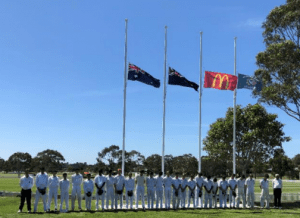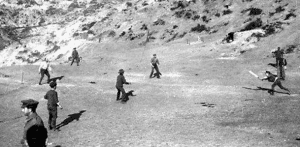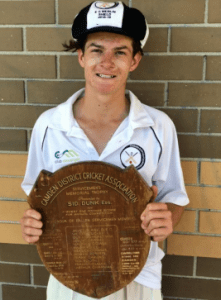 At 11am yesterday batsmen put down their bats and bowlers handed the cricket ball to the umpire as play was momentarily halted in the match between the Camden District under 15 Weblin Shield and Canterbury West DCA at Raby Sports Complex.
At 11am yesterday batsmen put down their bats and bowlers handed the cricket ball to the umpire as play was momentarily halted in the match between the Camden District under 15 Weblin Shield and Canterbury West DCA at Raby Sports Complex.
Sunday, November 11, 2018 marked the 100th anniversary of the signing of Armistice which ended World War I.
The young players lined up side by side while the Ode of Remembrance was recited, a minute’s silence was observed and the flags lowered at the home of Macarthur cricket.
Less than 30 metres away, inside the Campbelltown Camden District Cricket Club’s clubroom was an ageing trophy housed in a magnificent cabinet donated by the Ingleburn RSL.
The old home made wooden shield was first awarded in 1946 to the Orangeville Cricket Club.
Proudly titled the Servicemen’s Memorial Trophy, it was awarded for the “Highest One Innings Score for Annual Competition” in the Camden District Cricket Association (CDCA).
The 72 year old shield shares a significant amount of Macarthur cricketing history – apart from the fact that Orangeville amassed 9/473 on March 9, 1946 to claim it that season.
For starters it lists the names of the fallen servicemen members of the CDCA – local cricketers who laid down the bat for a rifle or as Welsh author Andrew Hignell sys: went from the “front foot to the front line” and paid the ultimate sacrifice.
These names include: James Clark, D.F.C. Victor Tuckey, Gus Longhurst, M.M. Maurice Dowle, Keven Reilly, Derrick Downes, Hughie Roberts, Frank Carling, Ted Booth, Frank Colman, Ern McGrath and Arthur Chapman.
One can only assume that given the date of the Servicemen’s Memorial Trophy being struck, the above gallant men served in WWII.
The Anzacs and cricket shared a tight bond.
Many stories abound of the relief they found from the game when under extreme circumstances.
Stories are told of five-day Test matches being played inside Changi Prison or the fact when many an air strip was built in a war zone soon after completion 22 yards was marked precisely on the reasonably flat surface.
 Camden’s George MacLeay Macarthur Onslow is cast as a central figure in one of Australia’s most poignant and evocative cricket images.
Camden’s George MacLeay Macarthur Onslow is cast as a central figure in one of Australia’s most poignant and evocative cricket images.
As Commanding Officer of the 7th Light Horse Regiment in the final weeks of the doomed Gallipoli campaign, 40-year-old Major Macarthur Onslow was the pivotal figure in organising a cricket match that has come to symbolise much of Australia’s most eulogised military engagement.
Andrew Ramsay from cricket.com.au writes: “Despite his tall, athletic stature, McArthur Onslow’s batsmanship showed neither the extravagant flamboyance of Victor Trumper nor the compact elegance of Jack Hobbs – the rival poster boys for cricket in the years prior to the pall of The Great War.
On 17 December 1915, the day before the mass evacuation of the 20,000 remaining Australia and New Zealand troops from Anzac Cove was stealthily completed under cloak of night, he staged an impromptu game at Shell Green.”
The photograph included here (above) shows Macarthur Onslow wielding a bat amid a tight ring-field of soldiers clad in service caps and slouch hats at Shell Green, the only flat section of land within the ANZAC perimeter, which took its name from the heavy hail of Turkish artillery that regularly rained down from the overlooking hills.
George MacLeay Macarthur Onslow was born May 2, 1875 in Camden.
He was the great grandson of John Macarthur and Elizabeth Macarthur.

When his father Arthur Onslow died in 1882, his mother Elizabeth changed her name to Macarthur Onslow and took George and his five siblings to England in 1887.
There George was educated at Rugby School, while his mother studied dairy farming.
On returning to Camden in 1889 she founded a dairy farming complex, the Camden Vale Milk Co, which eventually merged with the Dairy Farmers’ Co-operative Milk Co in 1928.
Six years after returning with his mother Elizabeth, George joined the military. He served until January 1919, when he was evacuated with typhoid and returned to Australia four months later.
After the war, Macarthur Onslow was elected to Wollondilly Shire Council as well Camden Council, before becoming Mayor of Camden.
No doubt he also resumed his cricket skills throughout the summer months.
At 11am on Sunday, November 11, 2018, the Camden DCA under 15 captain Will Salzman recited the Ode of Remembrance in front of spectators, umpires and players at the Raby Sports Complex.
A simple ceremony repeated across the many cricket grounds of Australia where all fallen servicemen and servicewomen, like those 12 local cricketers listed above, were remembered.
In a remarkable outcome for the Weblin Shield clash, the junior representative match was declared a tie when both teams finished with 164 runs each.
Lest We Forget.
– JASON ELLSMORE
